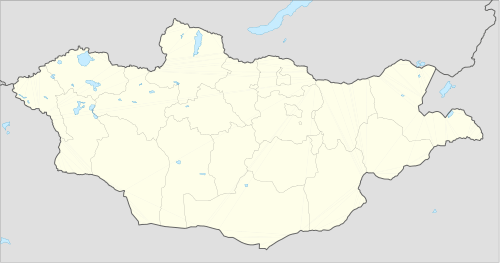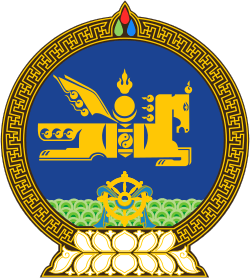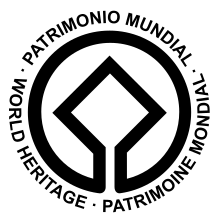List of World Heritage sites in Mongolia
Location of UNESCO World Heritage sites in Mongolia
The United Nations Educational, Scientific and Cultural Organization (UNESCO) World Heritage sites are places of importance to cultural or natural heritage as described in the UNESCO World Heritage Convention, established in 1972.
To date, 4 sites, including 3 cultural and 1 natural, have been inscribed from Mongolia. On site, the Uvs Nuur Basin, is a transboundary site including areas in both Mongolia and Russia, and is one of the largest sites inscribed as a World Heritage.
World Heritage sites
| Site | Image | Location | Year listed | UNESCO data | Description |
|---|---|---|---|---|---|
| Uvs Nuur Basin | Uvs Lake (transboundary, Mongolia and Russia) 50°16′30″N 92°43′11″E / 50.27500°N 92.71972°E | 2003 | ix, x (Natural) |
The Uvs Nuur Basin (1,068,853 ha), is the northernmost of the enclosed basins of Central Asia. It takes its name from Uvs Nuur Lake, a large, shallow and very saline lake, important for migrating birds, waterfowl and seabirds. The site is made up of twelve protected areas representing the major biomes of eastern Eurasia. The steppe ecosystem supports a rich diversity of birds and the desert is home to a number of rare gerbil, jerboas and the marbled polecat. The mountains are an important refuge for the globally endangered snow leopard, mountain sheep (argali) and the Asiatic ibex.[1] | |
| Orkhon Valley Cultural Landscape | Orkhon River Valley (Arkhangai Province, Övörkhangai Province, Bulgan Province, Selenge Province) 47°33′24″N 102°49′53″E / 47.55667°N 102.83139°E | 2004 | ii, iii, iv (Cultural) |
The 121,967-ha Orkhon Valley Cultural Landscape encompasses an extensive area of pastureland on both banks of the Orkhon River and includes numerous archaeological remains dating back to the 6th century. The site also includes Kharkhorum, the 13th- and 14th-century capital of Chingis (Genghis) Khan’s vast Empire. Collectively the remains in the site reflect the symbiotic links between nomadic, pastoral societies and their administrative and religious centres, and the importance of the Orkhon valley in the history of central Asia. The grassland is still grazed by Mongolian nomadic pastoralists.[2] | |
| Petroglyphic Complexes of the Mongolian Altai |  |
Altai Mountains (Bayan-Olgii Province) 49°20′2″N 88°23′43″E / 49.33389°N 88.39528°E | 2011 | iii (Cultural) |
The numerous rock carvings and funerary monuments found in these three sites illustrate the development of culture in Mongolia over a period of 12,000 years. The earliest images reflect a time (11,000 - 6,000 BC) when the area was partly forested and the valley provided a habitat for hunters of large game. Later images show the transition to herding as the dominant way of life. The most recent images show the transition to a horse-dependent nomadic lifestyle during the early 1st millennium BC, the Scythian period and the later Turkic period (7th and 8th centuries AD). The carvings contribute valuably to our understanding of pre-historic communities in northern Asia.[3] |
| Great Burkhan Khaldun Mountain and its surrounding sacred landscape |  |
Khentii Province 48°45′43.12″N 109°0′33.5″E / 48.7619778°N 109.009306°E | iv, vi (Cultural) |
2015 | The site is situated in the north-east of the country in the central part of the Khentii mountain chain where the vast Central Asian steppe meets the coniferous forests of the Siberian taiga. Burkhan Khaldun is associated with the worship of sacred mountains, rivers and ovoo-s (shamanic rock cairns), in which ceremonies have been shaped by a fusion of ancient shamanic and Buddhist practices. The site is also believed to be the place of Genghis Khan’s birth and burial. It testifies to his efforts to establish mountain worship as an important part of the unification of the Mongol people.[4] |
| Landscapes of Dauria | 49°55′48.8″N 115°25′31.6″E / 49.930222°N 115.425444°E | ix, x (Natural) |
2017 | Shared between Mongolia and the Russian Federation, this site is an outstanding example of the Daurian Steppe eco-region, which extends from eastern Mongolia into Russian Siberia and northeastern China. Cyclical climate changes, with distinct dry and wet periods lead to a wide diversity of species and ecosystems of global significance. The different types of steppe ecosystems represented, such as grassland and forest, as well as lakes and wetlands serve as habitats for rare species of fauna, such as the White-naped crane, Great Bustard, Relict Gull and Swan goose, as well as millions of vulnerable, endangered or threatened migratory birds. It is also a critical site on the transboundary migration path for the Mongolian gazelle.[5] |
Tentative list
- Desert Landscapes of the Mongolian Great Gobi (2014)
- Cretaceous Dinosaur Fossil Sites in the Mongolian Gobi (2014)
- Eastern Mongolian Steppes (2014)
- Amarbayasgalant Monastery and its Surrounding Sacred Cultural Landscape (2014)
- Baldan Bereeven Monastery and its Sacred Surroundings (2014)
- Sacred Binder Mountain and its Associated Cultural Heritage Sites (2014)
- Funeral Sites of the Xiongnu Elite (2014)
- Archaeological Site at Khuduu Aral and Surrounding Cultural Landscape (2014)
- Deer Stone Monuments, the Heart of Bronze Age Culture (2014)
- Petroglyphic Complexes in the Mongolian Gobi (2014)
- Highlands of Mongol Altai (2014)
- Sacred Mountains of Mongolia (2015)
Nominations Cooperation
India, Nepal, Bhutan, Japan, and the Philippines have supported more nominations for Mongolia since 2002. Russia has cooperated with Mongolia since 2017.
References
- ↑ "Uvs Nuur Basin". UNESCO World Heritage. Retrieved 23 March 2018.

- ↑ "Orkhon Valley Cultural Landscape". UNESCO World Heritage. Retrieved 23 March 2018.

- ↑ "Petroglyphic Complexes of the Mongolian Altai". whc.unesco.org. UNESCO World Heritage. Retrieved 23 March 2018.

- ↑ "Great Burkhan Khaldun Mountain and its surrounding sacred landscape". UNESCO World Heritage. Retrieved 23 March 2018.

- ↑ "Landscapes of Dauria". UNESCO World Heritage. Retrieved 23 March 2018.

External links
This article is issued from
Wikipedia.
The text is licensed under Creative Commons - Attribution - Sharealike.
Additional terms may apply for the media files.


